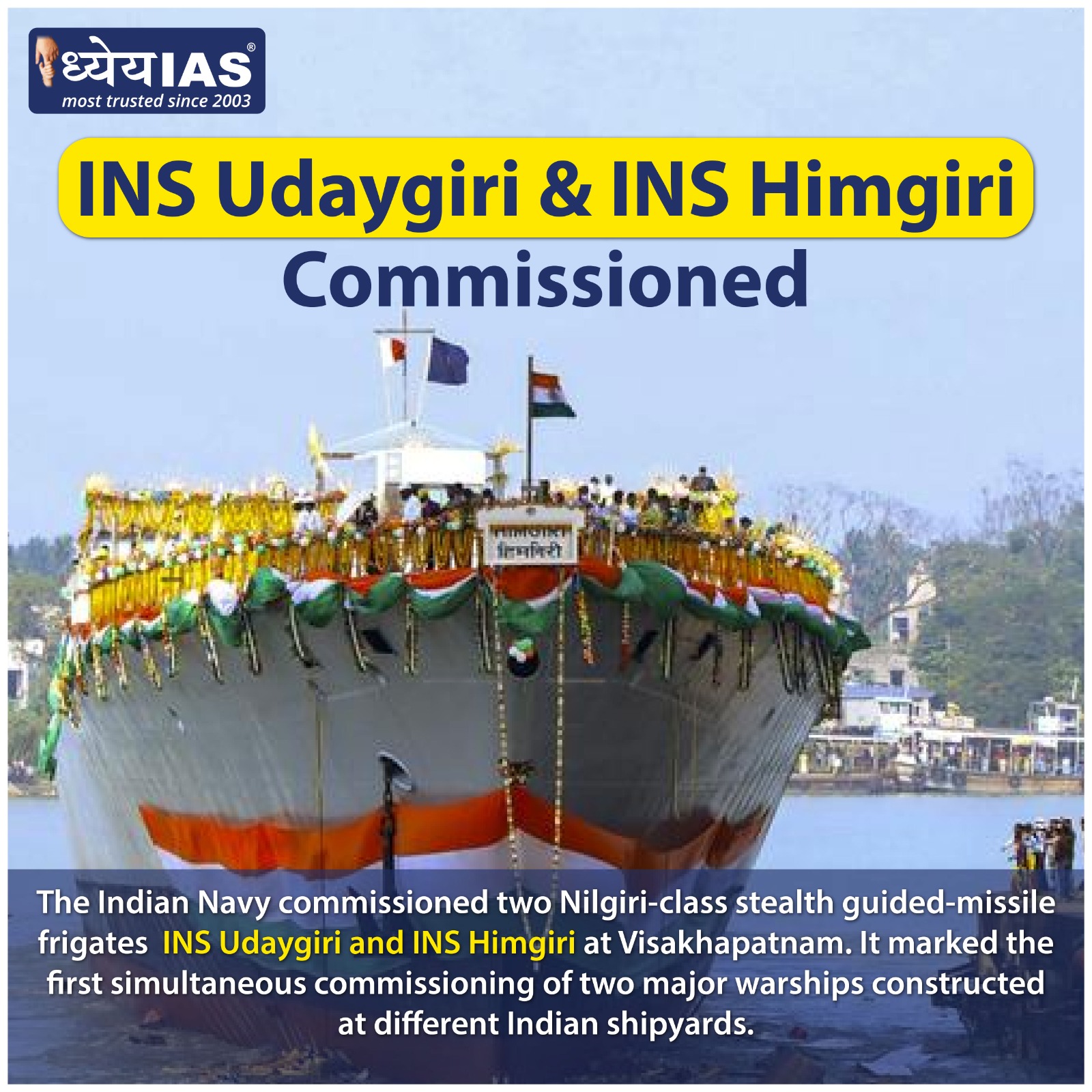Context:
On August 26, 2025, the Indian Navy commissioned two Nilgiri-class stealth guided-missile frigates INS Udaygiri and INS Himgiri at Visakhapatnam. This is the first simultaneous commissioning of two major warships constructed at different Indian shipyards.
About Project 17A and Nilgiri-Class:
Both ships are part of Project 17A, which is the Nilgiri-class stealth frigate project. These ships are an improved version of the earlier Shivalik-class (Project 17).
· INS Udaygiri: Second ship of Project 17A, built by Mazagon Dock Shipbuilders Limited (MDL), Mumbai.
· INS Himgiri: First Project 17A ship built by Garden Reach Shipbuilders and Engineers (GRSE), Kolkata.
INS Udaygiri is also the 100th ship designed by the Navy’s Warship Design Bureau, showing the strength of India’s own design capability.
In total, there will be seven Nilgiri-class frigates: four (Nilgiri, Udaygiri, Taragiri, Mahendragiri) built by MDL and three (Himgiri, Dunagiri, Vindhyagiri) by GRSE.
The Ministry of Defence has said that 75% of the equipment orders have gone to Indian companies, involving over 200 MSMEs, and generating about 4,000 direct and 10,000 indirect jobs.
Major Features of Nilgiri-class Frigates:
Nilgiri-class frigates are designed for multiple roles and can operate in the open seas, facing both traditional and new security threats.
· Surface-to-Air weapons: Long Range Surface-to-Air Missiles (LRSAM), Barak 8 missiles.
· Surface-to-Surface weapons: Eight BrahMos supersonic cruise missiles (vertically launched).
· Anti-Submarine Systems: Lightweight torpedoes, Indigenous Rocket Launcher (IRL), Humsa (NG) sonar.
· Artillery: 127 mm main gun, two AK-630 rapid-fire guns.
· Surveillance and Warfare: Multi-Mission Surveillance Radar, Shakti Electronic Warfare Suite, airborne early warning radar, and surface surveillance radar.
Technical Details:
· Length: 149 metres
· Displacement: About 6,670 tonnes
· Propulsion: Combined Diesel or Gas (CODOG)
· Speed: 28 knots
· Endurance: 5,500 nautical miles (economical), 1,000 nautical miles (maximum speed)
· Crew: Around 225 personnel
· Design: 4.54% larger hull than the Shivalik-class, but with reduced radar signature for better stealth.
Legacy of the Names:
The Nilgiri-class continues the names of older ships that served with honour.
· INS Udaygiri: Named after a mountain range in Andhra Pradesh. The earlier Udaygiri (1976–2007) took part in Op Pawan (1987), Op Dolphin and Op Cactus (1988), Op Madad (1991), and Op Castor (2005).
· INS Himgiri: Named after the snow-covered Himalayas. The earlier Himgiri (1974–2005) protected Bombay High Oil Fields, took part in Op Cactus (1988), and provided relief during the Gujarat earthquake (2001).
The new INS Udaygiri will serve under the Eastern Naval Command, and INS Himgiri under the Western Naval Command. Their mottos are:
· Udaygiri: Sanyuktaha Paramojayaha (“In togetherness there is great victory”)
· Himgiri: Adrushyam Ajayam (“Invisible and invincible”).
Conclusion:
Three Nilgiri-class frigates have now been commissioned. The other four will join the Navy within the next one and a half years. Looking ahead, the Navy is planning Project 17 Bravo (P-17B), which will build seven even more advanced frigates with better weapons, control systems, and higher use of Indian technology.







